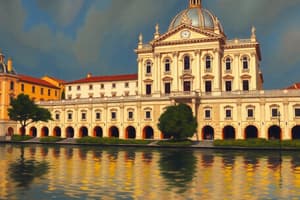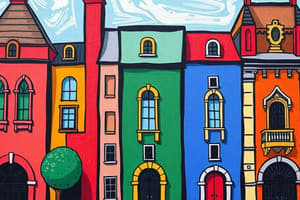Podcast
Questions and Answers
Match the architectural styles with their descriptions:
Match the architectural styles with their descriptions:
Classical = Derived from principles of Greek and Roman architecture Baroque = More ornate than the Renaissance, deliberate in its attempt to impress, lavish of all styles Rococo = Final phase of Baroque, characterized by profuse and semi-abstract ornamentation Art Nouveau = Style of fine and applied art characterized by fluid, undulating motifs, often derived from natural forms
What is the main characteristic of Neoclassicism architecture?
What is the main characteristic of Neoclassicism architecture?
monumentality
Which architectural style emphasizes the aesthetic use of basic building processes like cast-in-place concrete with no concern for visual amenity?
Which architectural style emphasizes the aesthetic use of basic building processes like cast-in-place concrete with no concern for visual amenity?
- Post Modernism
- Expressionism
- Brutalism (correct)
- Organic Architecture
Art Deco is characterized by bold colors, undulating motifs, and often derived from natural forms.
Art Deco is characterized by bold colors, undulating motifs, and often derived from natural forms.
______ is associated with lightness, swirling forms, flowing lines, ornate stucco work, and arabesque ornament.
______ is associated with lightness, swirling forms, flowing lines, ornate stucco work, and arabesque ornament.
Flashcards are hidden until you start studying
Study Notes
Architectural Styles
- Classical: Derived from Greek and Roman architecture, characterized by five orders of architecture (Tuscan, Doric, Ionic, Corinthian, Composite), and symmetrical proportions.
- Renaissance: Developed during the rebirth of classical art and learning in Europe, characterized by classical orders, round arches, and symmetrical proportions.
- Baroque: More ornate than the Renaissance, characterized by deliberate attempts to impress, lavish use of all styles.
- Rococo: Final phase of Baroque, characterized by profuse and semi-abstract ornamentation, associated with lightness, swirling forms, flowing lines, ornate stucco work, and arabesque ornament.
Medieval and Gothic Styles
- Romanesque: Emerged from Roman and Byzantine elements, characterized by massive articulated wall structures, arches, and vaults.
- Gothic: Revolutionary style of construction, emerged from Romanesque and Byzantine forms, characterized by delicate balance of forces, with thrusts directed throughout a rigid structural lattice.
19th and 20th Century Styles
- Art Nouveau: Characterized by fluid, undulating motifs, often derived from natural forms.
- Art Deco: Style Moderne, marked by geometric motifs, streamlined and sharply defined outlines, and often bold colors.
- International Style: Functional architecture devoid of regional characteristics, characterized by simple geometric forms, large untextured white surfaces, and general use of steel or reinforced concrete construction.
- Bauhaus: Concepts and ideas characterized by synthesis of technology, craft, and design aesthetics; emphasizes functional design.
Modern and Contemporary Styles
- Expressionism: Buildings treated as functional structures and sculptural objects.
- Brutalism: Emphasizes aesthetic use of basic building processes like cast-in-place concrete with no apparent concern for visual amenity.
- Postmodernism: Reaction against international style and modernism, encourages use of elements from historical vernacular styles and often playful illusion, decoration, and complexity.
- Organic Architecture: Expression of personal freedom, harmony between structure and environment, integration of individual parts to the whole concept, all forms should express natural use of elements.
- Deconstructivism: Neo-modern or post-structuralism, questions traditional assumptions and takes modernist abstraction to extreme and exaggerates known motifs.
- Evolutionary Architecture: Design grows and develops based on climatic and ecological elements as well as advances in technology, approached as a living organism as if natural forces had shaped the structure.
- Conceptual Architecture: Invisible or imaginary architecture, represents plans and drawings for buildings and cities that have never been constructed, pure research or speculation.
Studying That Suits You
Use AI to generate personalized quizzes and flashcards to suit your learning preferences.




